photo: Riley Purgatory Bluff Creek Watershed District
Stream ID
Riley Creek is identified by stream Kittle number M-055-01 (NRRI, 2022) and Minnesota Pollution Control Agency (MPCA) assessment unit 07020012-511. This link connects to sample data described in the adjacent summary table. The sites are located at various points along the stream, above or below lakes, inflows, and other points that might affect the quality of the creek.
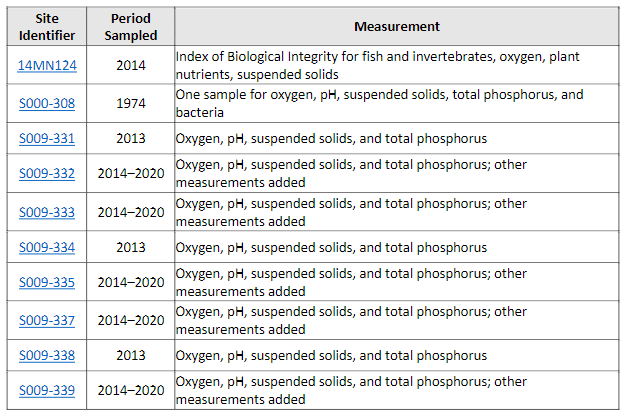
The Riley, Purgatory, Bluff Watershed District (RPBWD) collected most of the samples described in the above table. These samples, along with detailed field measurements were collected and made during the ice-free seasons. Staff of the RPBWD also periodically conduct assessments of erosion and habitat along selected reaches of the creek. Their information is summarized in annual or other periodic reports like: Riley Creek 2019.
Riley Creek is a 10-mile (16-kilometer) long stream located in Hennepin County that drains about 13 square miles (3,400 hectares) (MetCo, 2014). It begins at Lake Lucy in Chanhassen and runs through lakes, open land, urban areas and the Minnesota Valley National Wildlife Refuge before discharging to the Minnesota River. The watershed is 7% commercial, 3% farmland, 29% residential, 40% open space, and 7% roads (RPBWD, 2019). Riley Creek is listed as impaired for aquatic life because of benthic macroinvertebrate and fish bioassessments and turbidity (MPCA, 2022). Aquatic recreation in Riley Creek is impaired because of Escherichia coli (MPCA, 2022).
The Metropolitan Council of Environmental Services (MCES) samples Riley Creek at the inlet to Grass Lake 1.3 miles (1.9 kilometers) upstream of the confluence with the Minnesota River as part of the Comprehensive Water Quality Assessment of Select Metropolitan Area Streams (MCES, 2014), also known as the Watershed Outlet Monitoring Program (WOMP) (MCES, 2017). This sampling site encompasses most of the Riley Creek watershed and has the most comprehensive set of data collected during all seasons. The measurements and analyses performed include a broad group of constituents including major ions, trace elements, biological indicators, plant nutrients, and other indicators of stream productivity. Selected results from analysis of samples collected from the creek are summarized in the following graphsi.
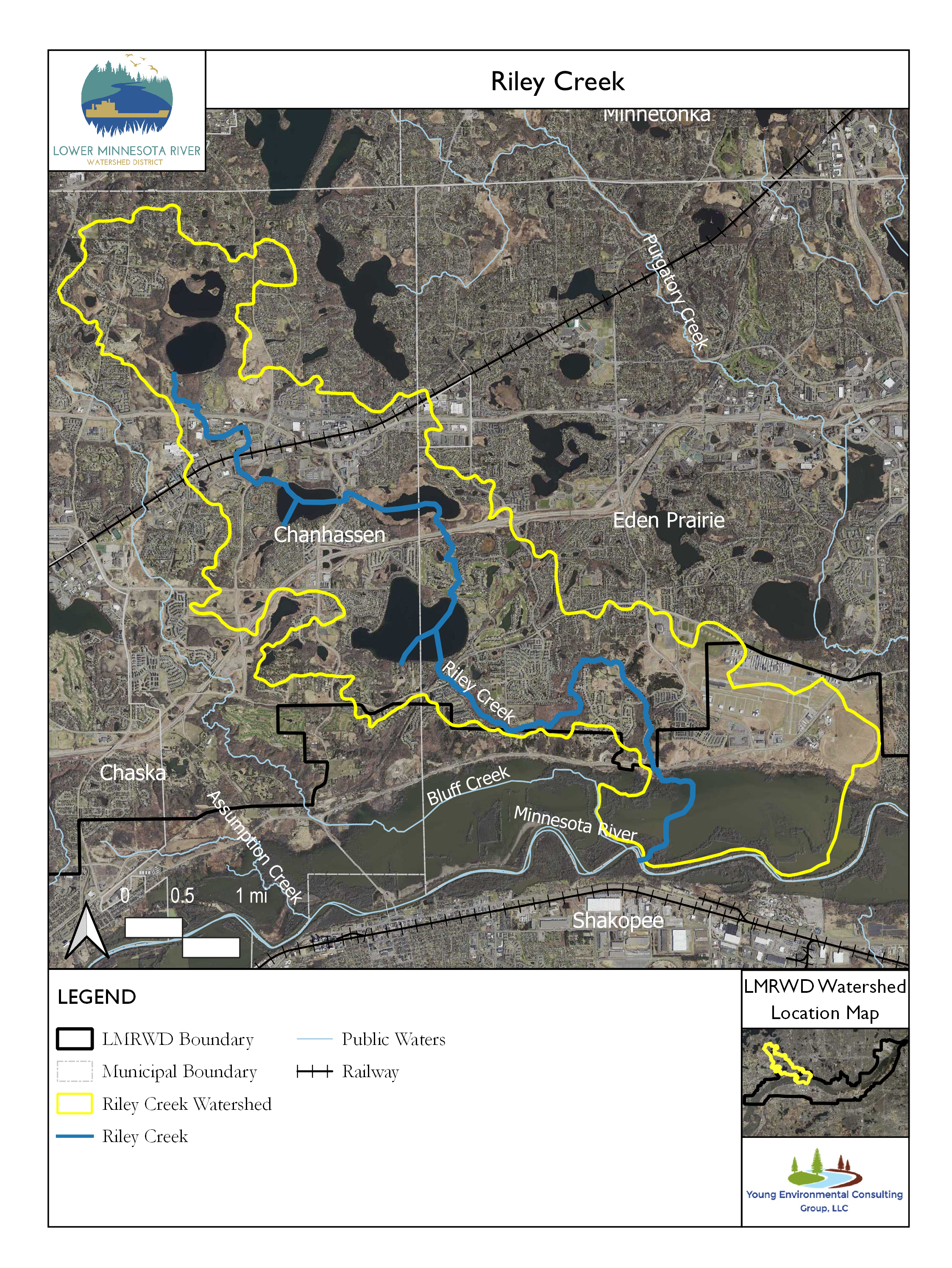
Monitoring Data
Streamflow
Streamflow, the amount of water carried by the creek at the sampling site, was usually measured each time a sample was collected. The streamflow data are processed separately from the other data so the streamflow measurements for 2021 had not been updated in the database when the data were downloaded on April 4, 2022. Lakes upstream of the sampling site control the extreme flows typical of most creeks of this size. Streamflow rarely drops below 1 cubic feet per second.
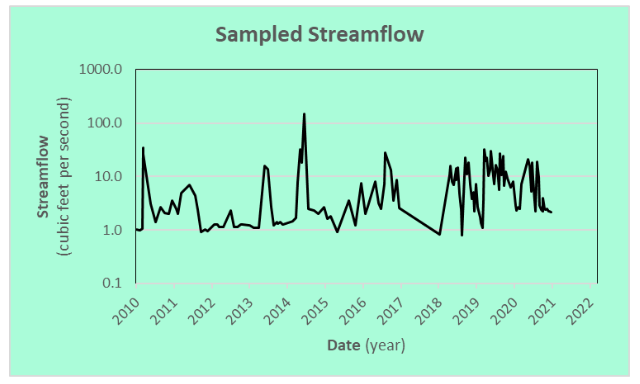
Water Temperature
The water temperature of Riley Creek is important for habitat because warmer water holds less dissolved oxygen needed by aquatic organisms. Temperatures at the sampling site fluctuate seasonally, sometimes approaching 77 degrees Fahrenheit (°F, 25°C) in the summer and near 32°F (0°C) in the winter.
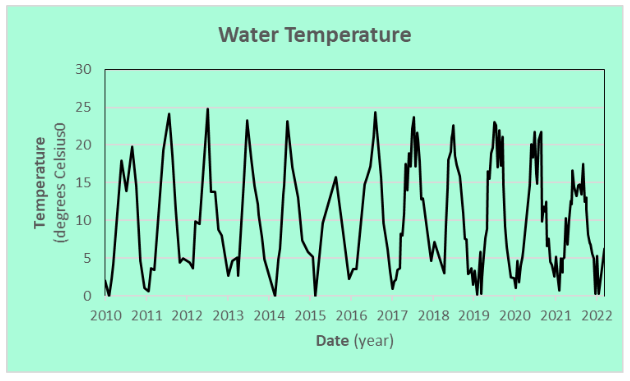
Dissolved Oxygen
Measurements of dissolved oxygen (DO) concentration show that Riley Creek remains well oxygenated. Many aquatic animals typically need at least 5 milligrams per liter (mg/L) of DO (MNDNR, 2021). Seasonal fluctuations are normal as the solubility of oxygen changes with the temperature of the water.
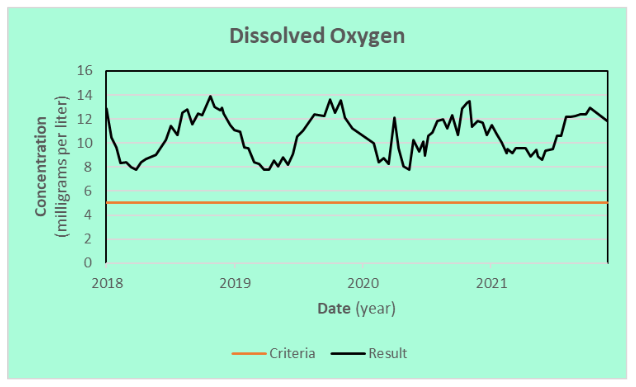
Chloride
Chloride, a primary component of road deicing and water-softening salt, represents a growing concern for many streams and lakes. The chronic standard for chloride in Minnesota waters to protect cool and warm water fisheries is 230 mg/L (MPCA 2018).
The adjacent chart shows the Riley Creek chloride concentrations since routine sampling started in 2014. Peak concentrations have approached 200 mg/L, well below the chronic standard.
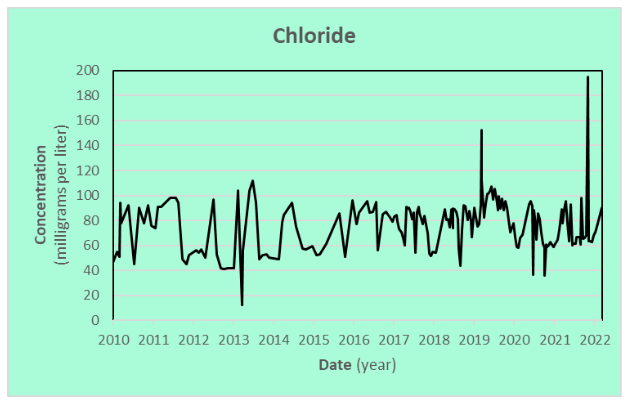
Phosphorus
Phosphorus is an essential plant nutrient that is carried by streams. Naturally occurring phosphorus concentrations may be supplemented from animal wastes and fertilizers, and it often is introduced with runoff. Phosphorus often is associated with sediment but is more available to plants when it is dissolved in the water. The adjacent charts show the concentrations of phosphorus in samples from Riley Creek. The first chart shows the total amount of phosphorus in the water including the part associated with suspended sediment and other particulate matter. The second chart shows the phosphorus remaining in the water after the sample has been filtered to remove the sediment-associated phosphorus.
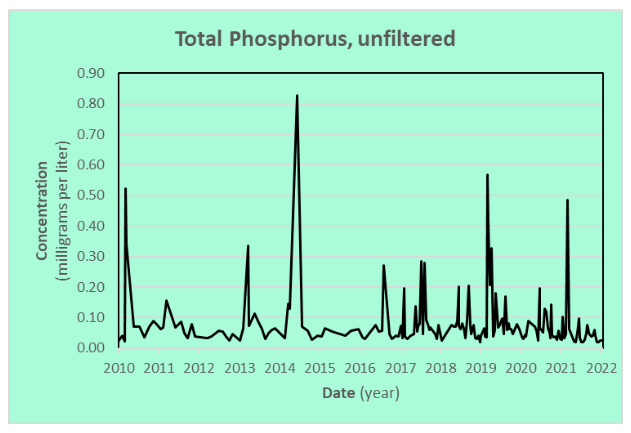
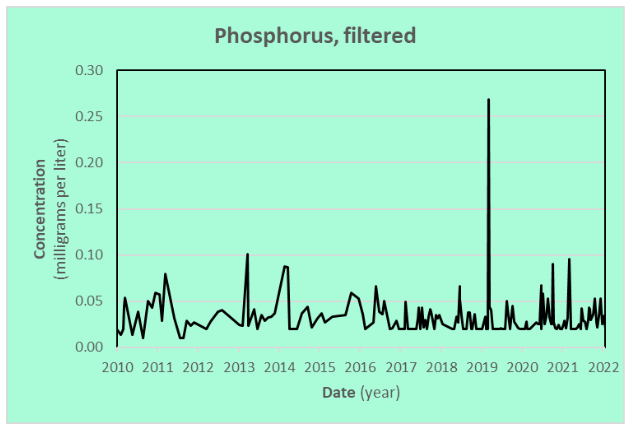
Escherichia coli
Escherichia coli (E. coli) is an organism used to indicate the amount of fecal contamination in lakes and streams. Swimming in or ingesting water with high levels of E. coli could result in illness. Riley Creek E. coli levels appear to exceed the allowable limit for recreational and human health. The allowable limit is a monthly average of less than 126 colony-forming units per 100 milliliters of water between April and October (MPCA, 2021).
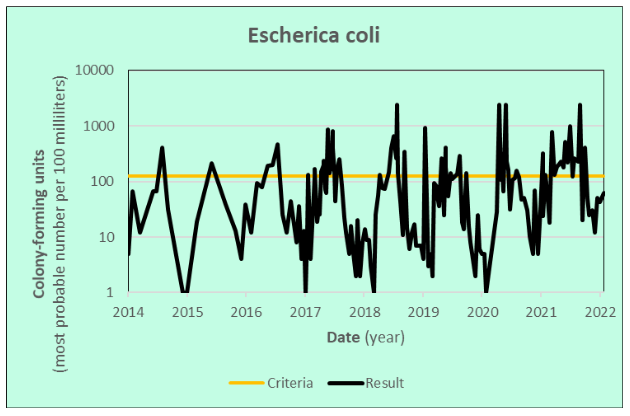
References
MCES. (2014). Comprehensive water quality assessment of select metropolitan area streams. St. Paul, MN: Metropolitan Council Environmental Services. Retrieved from https://metrocouncil.org/Wastewater-Water/Services/Water-Quality-Management/Stream-Monitoring-Assessment/Minnesota-River-Tributary-Streams-Assessment.aspx
MCES. (2017). Joint Powers Agreement with the Minnesota Pollution Control Agency for the Watershed Outlet Monitoring Program. St. Paul, MN: Metropolitan Council Environmental Services. Retrieved Mar 31, 2022, from https://metrocouncil.org/Council-Meetings/Committees/Metropolitan-Council/2017/12-13-17/1213_2017_288-SW.aspx
MetCo. (2014). Riley Creek Fact Sheets. St. Paul, MN: Metropolitan Council. Retrieved Apr 4, 2022, from https://metrocouncil.org/Wastewater-Water/Services/Water-Quality-Management/Stream-Monitoring-Assessment/Minnesota-River-Tributary-Streams-Assessment/Mn-River-Trib-Assessment-Reports/Riley-Creek-Factsheet.aspx
MNDNR. (2021). Stream basics | Minnesota DNR. Retrieved Nov 3, 2021, from https://www.dnr.state.mn.us/fishing/trout_streams/stream_basics.html
MPCA. (2018, May 18). TCMA Chloride TMDL - Applicable Water Quality Standards and Numeric Water Quality Targets. Retrieved Nov 8, 2021, from https://stormwater.pca.state.mn.us/index.php/TCMA_Chloride_TMDL_-_Applicable_Water_Quality_Standards_and_Numeric_Water_Quality_Targets
MPCA. (2021, Jan). Water quality and bacteria frequently asked questions. St. Paul, MN: Minnesota Polution Control Agency. Retrieved Mar 31, 2022, from https://www.pca.state.mn.us/sites/default/files/wq-s1-93.pdf
MPCA. (2022, Apr). Minnesota's Impaired Waters List. (M. P. Agency, Producer) Retrieved Jun 21, 2022, from Imparied Waters: draft 2022: https://www.pca.state.mn.us/water/minnesotas-impaired-waters-list
MPCA. (n.d.). Riley Creek: Riley Lk to Minnesota R (Stream). Retrieved Apr 4, 2022, from Lakes and streams water quality dashboard: https://webapp.pca.state.mn.us/surface-water/impairment/07020012-511
NRRI. (2022). Minnesota Natural Resources Atlas. (N. R. Institute, Producer) Retrieved Mar 23, 2022, from https://mnatlas.org/
RPBWD. (2019). Riley_Creek_2019.pdf. Chanhassen, MN: Riley Purgatory Bluff Watershed District. Retrieved Apr 4, 2022, from Riley Purgatory Bluff Creek Watershed District: https://rpbcwd.org/application/files/1415/8515/3115/Riley_Creek_2019.pdf
RPBWD. (n.d.). Riley Creek. Retrieved Apr 4, 2022, from Riley Creek: https://rpbcwd.org/waterbody/riley-creek
This data was last updated April 2022.